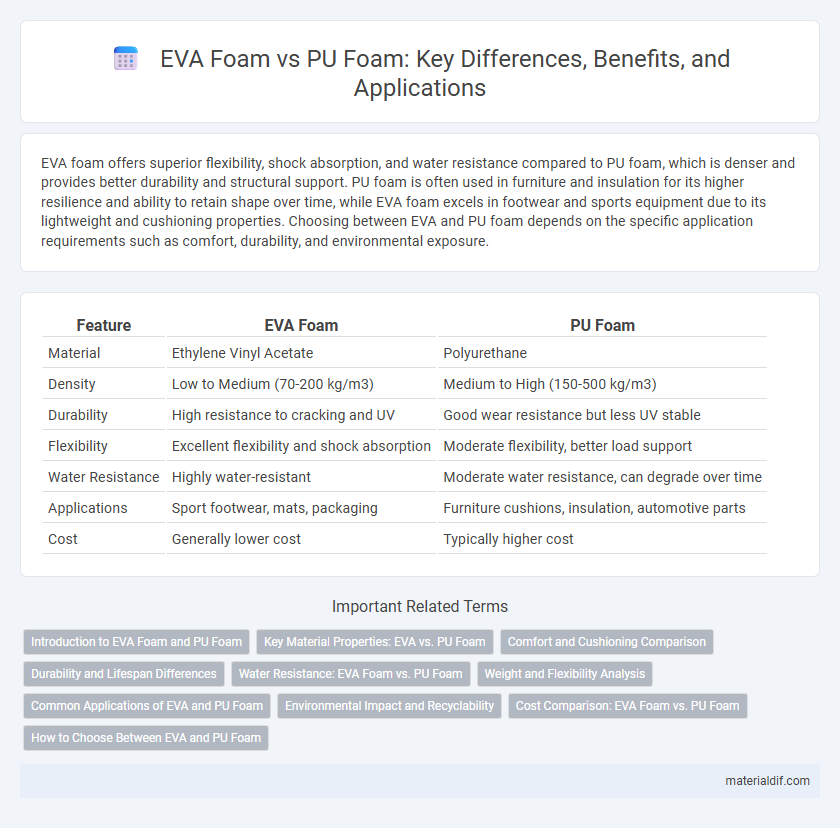EVA foam offers superior flexibility, shock absorption, and water resistance compared to PU foam, which is denser and provides better durability and structural support. PU foam is often used in furniture and insulation for its higher resilience and ability to retain shape over time, while EVA foam excels in footwear and sports equipment due to its lightweight and cushioning properties. Choosing between EVA and PU foam depends on the specific application requirements such as comfort, durability, and environmental exposure.
Table of Comparison
| Feature | EVA Foam | PU Foam |
|---|---|---|
| Material | Ethylene Vinyl Acetate | Polyurethane |
| Density | Low to Medium (70-200 kg/m3) | Medium to High (150-500 kg/m3) |
| Durability | High resistance to cracking and UV | Good wear resistance but less UV stable |
| Flexibility | Excellent flexibility and shock absorption | Moderate flexibility, better load support |
| Water Resistance | Highly water-resistant | Moderate water resistance, can degrade over time |
| Applications | Sport footwear, mats, packaging | Furniture cushions, insulation, automotive parts |
| Cost | Generally lower cost | Typically higher cost |
Introduction to EVA Foam and PU Foam
EVA foam, made from ethylene-vinyl acetate copolymer, offers excellent flexibility, durability, and impact absorption, making it ideal for applications like footwear and sports equipment. PU foam, or polyurethane foam, provides superior cushioning, resilience, and insulation properties, commonly used in upholstery, mattresses, and automotive seating. Both foams differ in density, compression resistance, and water absorption, influencing their suitability across various industrial and consumer products.
Key Material Properties: EVA vs. PU Foam
EVA foam exhibits excellent flexibility, resilience, and compression set resistance, making it ideal for footwear midsoles and sports equipment. PU foam offers superior cushioning, durability, and energy absorption, commonly used in furniture and automotive seating. Both materials differ significantly in density, tensile strength, and water resistance, influencing their suitability for specific applications.
Comfort and Cushioning Comparison
EVA foam offers superior shock absorption and lightweight cushioning, making it ideal for footwear and sports equipment focused on comfort during prolonged use. PU foam provides denser support with greater durability, often preferred in furniture and mattresses where long-term cushioning and resilience are critical. Both materials vary in comfort levels based on density and application, but EVA foam generally excels in flexibility and softness, while PU foam delivers firmer, more stable cushioning.
Durability and Lifespan Differences
EVA foam offers superior durability with excellent resistance to cracking, UV exposure, and compression, making it ideal for long-term applications. PU foam, while softer and more flexible, tends to degrade faster under environmental stress and may lose shape over time. The lifespan of EVA foam can exceed several years under heavy use, whereas PU foam typically lasts shorter due to its susceptibility to wear and breakdown.
Water Resistance: EVA Foam vs. PU Foam
EVA foam offers superior water resistance due to its closed-cell structure, preventing moisture absorption and making it ideal for marine and outdoor applications. In contrast, PU foam is more porous and absorbs water, which can lead to degradation and loss of cushioning over time when exposed to wet environments. Selecting EVA foam ensures long-term durability and performance in water-exposed conditions compared to PU foam.
Weight and Flexibility Analysis
EVA foam offers a lightweight structure with excellent flexibility, making it ideal for applications requiring cushioning and shock absorption without added bulk. PU foam tends to be denser and heavier, providing greater firmness and durability but sacrificing some flexibility. The choice between EVA and PU foam hinges on the balance between weight sensitivity and the desired level of pliability for specific uses.
Common Applications of EVA and PU Foam
EVA foam, known for its excellent shock absorption and flexibility, is commonly used in sports equipment, footwear insoles, and padding for protective gear. PU foam, valued for its high resilience and cushioning properties, is frequently utilized in furniture upholstery, mattresses, and automotive seating. Both foam types serve critical roles in industries requiring durable, comfortable, and lightweight materials.
Environmental Impact and Recyclability
EVA foam exhibits greater environmental benefits than PU foam due to its lower toxicity and enhanced biodegradability, making it less harmful during disposal and degradation. PU foam recycling remains challenging because of its complex chemical structure, often resulting in landfill accumulation and increased environmental pollution. EVA foam's closed-cell structure allows more efficient recycling processes, reducing waste and promoting sustainability in foam manufacturing and end-of-life management.
Cost Comparison: EVA Foam vs. PU Foam
EVA foam generally costs more than PU foam due to its higher durability and water resistance, making it suitable for premium applications like sports gear and orthotics. PU foam offers a budget-friendly option with good cushioning properties but tends to degrade faster under moisture and heavy use. Choosing between EVA and PU foam depends largely on balancing upfront costs with long-term performance needs.
How to Choose Between EVA and PU Foam
Selecting between EVA foam and PU foam depends on application requirements such as durability, flexibility, and cushioning properties. EVA foam offers excellent shock absorption and chemical resistance, making it ideal for sports equipment and insulation, while PU foam provides superior comfort and support, commonly used in furniture and bedding. Consider factors like density, resilience, cost, and environmental impact to make an informed decision tailored to specific usage needs.
EVA Foam vs PU Foam Infographic

 materialdif.com
materialdif.com